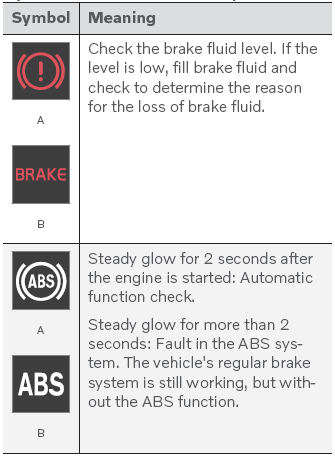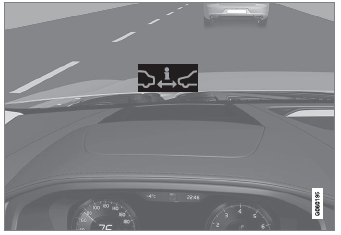Volvo XC90: Starting and driving / Brakes
The brake pedal is used to apply the vehicle's regular brakes, which are part of the brake system.
The vehicle is equipped with two brake circuits. If one brake circuit is damaged, the brake pedal may go down further when depressed. More pressure will then be required from the driver for normal braking effect.
The driver's pressure on the brake pedal is enhanced by a power braking function.
WARNING
Power braking only functions if the engine is running.
If the brake pedal is used when the engine is turned off, the pedal will feel stiffer than usual and greater pressure must be applied to brake the vehicle.
In very hilly areas or when driving with a heavy load, engine braking in manual gear should be used to augment the brakes. Engine braking is most effective if the same gear is used both uphill and downhill. Use the Off Road* drive mode to increase the engine braking effect when driving on steep downgrades at low speeds.
Anti-lock brakes
The vehicle is equipped with an Anti-lock Braking System (ABS1), which helps prevent the wheels from locking and helps maintain steering control when braking. Vibrations may be felt from the brake pedal when ABS is operating, which is normal.
After the vehicle is started, a brief test of the ABS system is automatically performed when the driver releases the brake pedal. An additional automatic test of the system may be performed when the vehicle is traveling at a low speed. During the test, the brake pedal may feel as though it is pulsating.
Symbols in the instrument panel

A In Canada.
B In the US.
WARNING
If the warning symbols for both brake fault and ABS fault are lit simultaneously, there may be a fault in the brake system.
If the brake fluid reservoir level is normal when this occurs, drive carefully to the nearest workshop to have the brake system checked - an authorized Volvo workshop is recommended.
If the brake fluid has fallen below the MIN level in the brake fluid reservoir, the vehicle should not be driven until the brake fluid has been filled. The reason for the brake fluid loss must be checked.
1 Anti-lock Braking System
* Option/accessory.
 Brake functions
Brake functions
The vehicle's brakes are used to reduce speed or prevent the vehicle from
rolling.
In addition to the wheel brakes and parking brakes, the vehicle is also equipped
with a number of automatic brake assist functions...
 Brake Assist System
Brake Assist System
The brake enhancing system, (BAS1), helps increase braking force
and can thereby reduce braking distance.
The system monitors the driver's braking habits and increases braking force when
necessary...
Other information:
Volvo XC90 2015-2026 Owners Manual: HD Radio™ sub-channels
In many cases, a main HD Radio station (FM wavebands only) will also have sub-channels offering additional types of programming or music. Sub-channels Example of an HD Radio station with sub-channels If any sub-channels are available, they will listed below the main channel on the screen...
Volvo XC90 2015-2026 Owners Manual: Climate control system service
Service and repairs on the air conditioning system should only be done by an authorized workshop. Troubleshooting and repairs The air conditioning system contains a fluorescent tracer substance. Ultraviolet light is used to search for leaks in the system...

